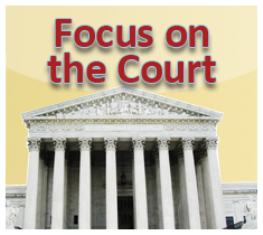
What a way to end this term at the Supreme Court! Yesterday, the Patient Protection and Affordable Care Act (ACA) was upheld in a 5-4 vote, with Chief Justice John Roberts writing the majority opinion. His opinion explained that the penalty imposed on an individual for not buying insurance would be considered a “tax,” but individual states have the right to deny the expansion of Medicaid, and the funds that come with that expansion. This decision has broad implications: Thousands upon thousands of people will no longer be denied coverage because of pre-existing conditions, millions of young adults will continue to be eligible for insurance through their parents’ plans, and women across the country will be able to access preventative care programs covered in the Women’s Health Amendment. Without a doubt, the last case handed down by the Court this term was the most anticipated, and possibly most important, case of decade. As the hype over the ACA dies down, we’re left with quite a roster of other major cases that were considered this year at SCOTUS:
- Hosanna-Tabor Evangelical Lutheran Church and School v. EEOC: The issue at hand in this case was whether a teacher at a private religious elementary school who teaches the full secular curriculum but also leads students in prayer and teaches religion class qualifies for the “ministerial exception,” which exempts certain religious institutions from federal laws prohibiting workplace discrimination. The Supreme Court unanimously overturned an earlier ruling and held that there is a "ministerial exception" from anti-discrimination laws. This decision marks the first time the Supreme Court has affirmed a wide range of federal Circuit Court opinions upholding the doctrine of the “ministerial exception.”
- Miller v. Alabama and Jackson v. Hobbs: In a 5-4 decision released this week, the Justices established that a mandatory minimum sentence of life without parole is unconstitutional for those under 18, and could be defined by the Eighth Amendment as “cruel and unusual punishment.”
- Kiobel v. Royal Dutch Petroleum Co.: This case posed the question of whether Indonesian villagers can sue Exxon Mobil Corp for alleged murder and torture committed by soldiers that the oil company hired to provide security for a natural gas plant. More broadly, the question was: whether defendants other than individuals can be held responsible in U.S. courts for overseas human rights violations, crimes against humanity, torture, murder, or other universal law violations. At the RAC, we were particularly interested in this case because the decision might give us insight into how exactly the Supreme Court views corporations and the way they should be treated under U.S. law (which is especially relevant as we consider the implications of Citizens United on campaign finance in the 2012 presidential elections). However, in conference in March, the Justices decided to add another question to the case: Whether and under what circumstances the Alien Tort Statute allows U.S. courts to consider and recognize violation of its laws within another country’s borders without violating that country’s sovereignty. Therefore, the case will be re-argued next term.
- United States v. Jones: The justices decided that, in this case, police violated the Constitution by not getting a warrant before using a global position system (GPS) device to track a suspect's movements. The decision brings the Fourth Amendment prohibition on unreasonable searches and seizures into the modern age. It also demonstrates that though the Founders could not have predicted today's technology, the rights with which all Americans are endowed are timeless.
- Arizona v. United States: The justices were considering the constitutionality of Arizona’s 2010 immigration law, S.B. 1070, which was more far-reaching than current federal immigration policy. The question at hand was: Does S.B. 1070 “complement or hinder federal immigration policy”? The Court’s general finding (according to a 5-3 decision) was that federal immigration law preempts state immigration law, although the Court neither considered nor ruled on the provision of the law that possibly encourages racial profiling.
While the cases that were considered at the Court were important this year, it’s also worth considering how the Court’s reputation has fared under public scrutiny; more than ever before, the Court has been tainted by accusations of increasing politicization. A CBS/New York Times poll showed that 76% of respondents believed that the justices allowed their decisions to be influenced by their personal opinions instead of solely on legal analysis. Regardless of whether this sentiment is based on reality, these numbers show that the Court’s reputation is at risk. As of June 7, public opinion of the Supreme Court had dropped to 44% (public approval of the Court was at 66% in the 1980s and 50% in 2000). Lee Epstein, a professor at the University of Southern California, observes that the decline in the court’s public opinion might be correlated with a general distaste for “big government,” or it could be based on the more specific phenomenon of highly politicized decisions with narrow votes and significant effects (particularly in Bush v. Gore and Citizens United). While the Supreme Court Justices will take a much-deserved recess until the next term starts in October, here at the RAC we will continue to fight for the vulnerable populations that are affected by each of these suits: the uninsured, the immigrants in our communities, those incarcerated in factories of harsh retribution, violence and criminal activity instead of centers of rehabilitation, those whose privacy is violated by the government or who wish to practice their religion without interference from their own government.
Related Posts

“We Were the Lucky Ones:” Bringing The Holocaust Out of History Books and Into Our Homes

Harnessing the Power of our Mothers Around the Seder Table

